Refer to the exhibit.
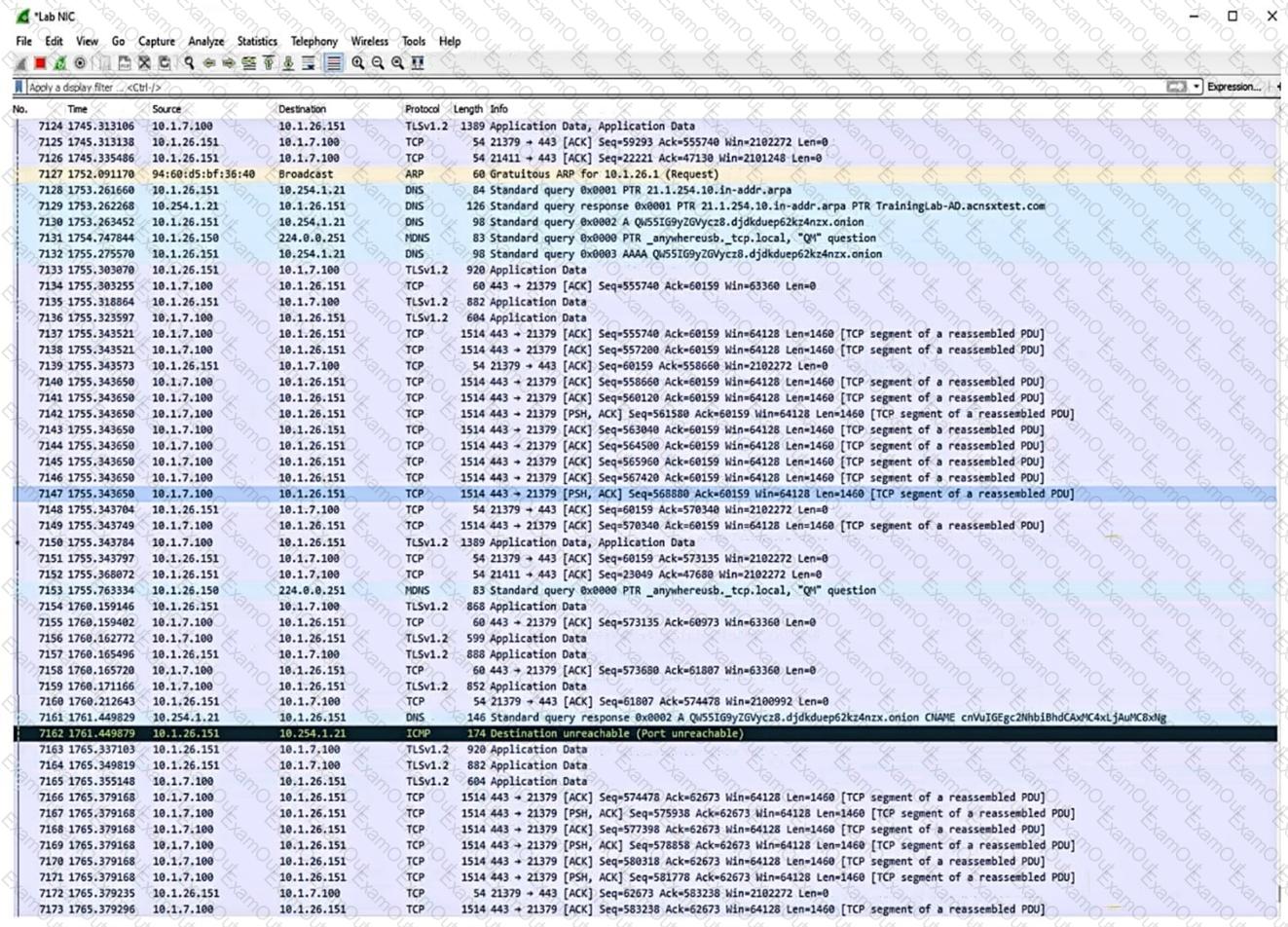
Which security issue is possibly indicated by this traffic capture?
You need to install a certificate on a standalone Aruba Mobility Controller (MC). The MC will need to use the certificate for the Web UI and for implementing RadSec with Aruba ClearPass Policy Manager. You have been given a certificate with these settings:
 Subject: CN=mc41.site94.example.com
Subject: CN=mc41.site94.example.com
 No SANs
No SANs
 Issuer: CN=ca41.example.com
Issuer: CN=ca41.example.com
 EKUs: Server Authentication, Client Authentication
EKUs: Server Authentication, Client Authentication
What issue does this certificate have for the purposes for which the certificate is intended?
A customer requires a secure solution for connecting remote users to the corporate main site. You are designing a client-to-site virtual private network (VPN) based on Aruba VIA and Aruba Mobility Controllers acting as VPN Concentrators (VPNCs). Remote users will first use the VIA client to contact the VPNCs and obtain connection settings.
The users should only be allowed to receive the settings if they are the customer's “RemoteEmployees” AD group. After receiving the settings, the VIA clients will automatically establish VPN connections, authenticating to CPPM with certificates.
What should you do to help ensure that only authorized users obtain VIA connection settings?
Refer to the scenario.
A customer requires these rights for clients in the “medical-mobile” AOS firewall role on Aruba Mobility Controllers (MCs):
 Permitted to receive IP addresses with DHCP
Permitted to receive IP addresses with DHCP
 Permitted access to DNS services from 10.8.9.7 and no other server
Permitted access to DNS services from 10.8.9.7 and no other server
 Permitted access to all subnets in the 10.1.0.0/16 range except denied access to 10.1.12.0/22
Permitted access to all subnets in the 10.1.0.0/16 range except denied access to 10.1.12.0/22
 Denied access to other 10.0.0.0/8 subnets
Denied access to other 10.0.0.0/8 subnets
 Permitted access to the Internet
Permitted access to the Internet
 Denied access to the WLAN for a period of time if they send any SSH traffic
Denied access to the WLAN for a period of time if they send any SSH traffic
 Denied access to the WLAN for a period of time if they send any Telnet traffic
Denied access to the WLAN for a period of time if they send any Telnet traffic
 Denied access to all high-risk websites
Denied access to all high-risk websites
External devices should not be permitted to initiate sessions with “medical-mobile” clients, only send return traffic.
The exhibits below show the configuration for the role.
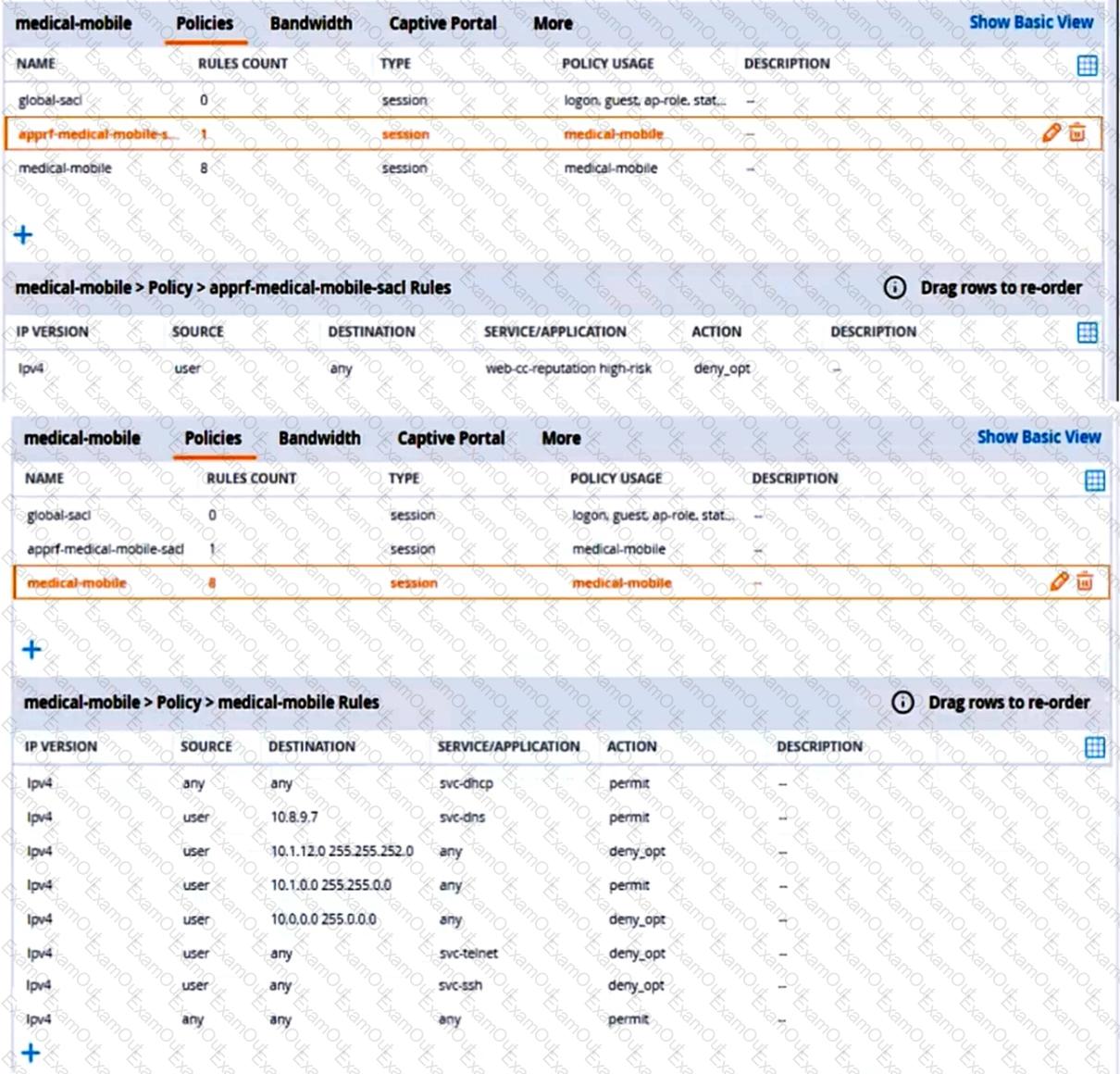
There are multiple issues with the configuration.
What is one of the changes that you must make to the policies to meet the scenario requirements? (In the options, rules in a policy are referenced from top to bottom. For example, “medical-mobile” rule 1 is “ipv4 any any svc-dhcp permit,” and rule 8 is “ipv4 any any any permit’.)
You are configuring gateway IDS/IPS settings in Aruba Central.
For which reason would you set the Fail Strategy to Bypass?
Refer to the scenario.
A customer has an Aruba ClearPass cluster. The customer has AOS-CX switches that implement 802.1X authentication to ClearPass Policy Manager (CPPM).
Switches are using local port-access policies.
The customer wants to start tunneling wired clients that pass user authentication only to an Aruba gateway cluster. The gateway cluster should assign these clients to the “eth-internet" role. The gateway should also handle assigning clients to their VLAN, which is VLAN 20.
The plan for the enforcement policy and profiles is shown below:
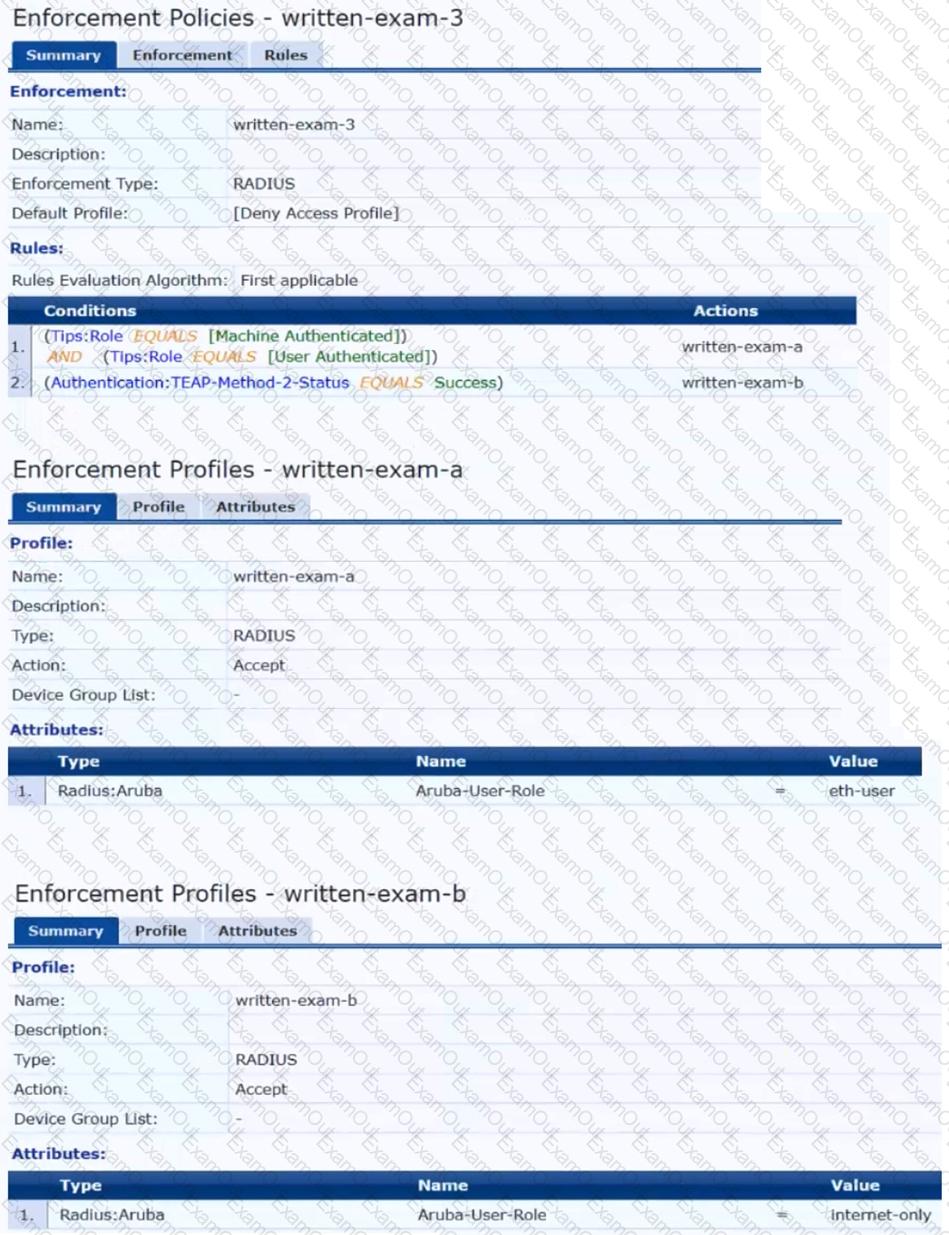
The gateway cluster has two gateways with these IP addresses:
• Gateway 1
o VLAN 4085 (system IP) = 10.20.4.21
o VLAN 20 (users) = 10.20.20.1
o VLAN 4094 (WAN) = 198.51.100.14
• Gateway 2
o VLAN 4085 (system IP) = 10.20.4.22
o VLAN 20 (users) = 10.20.20.2
o VLAN 4094 (WAN) = 198.51.100.12
• VRRP on VLAN 20 = 10.20.20.254
The customer requires high availability for the tunnels between the switches and the gateway cluster. If one gateway falls, the other gateway should take over its tunnels. Also, the switch should be able to discover the gateway cluster regardless of whether one of the gateways is in the cluster.
Assume that you have configured the correct UBT zone and port-access role settings. However, the solution is not working.
What else should you make sure to do?
Refer to the scenario.
# Introduction to the customer
You are helping a company add Aruba ClearPass to their network, which uses Aruba network infrastructure devices.
The company currently has a Windows domain and Windows CA. The Window CA issues certificates to domain computers, domain users, and servers such as domain controllers. An example of a certificate issued by the Windows CA is shown here.
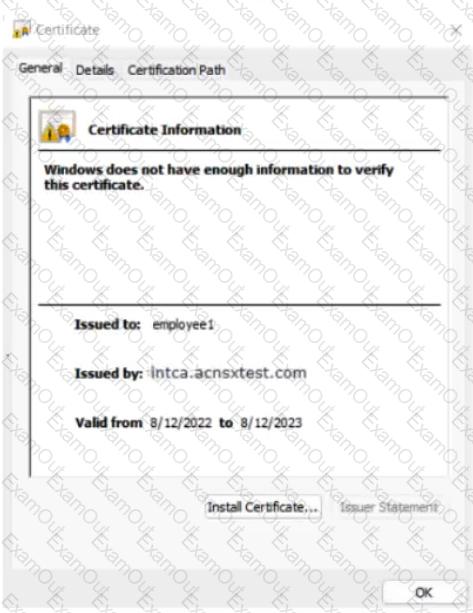
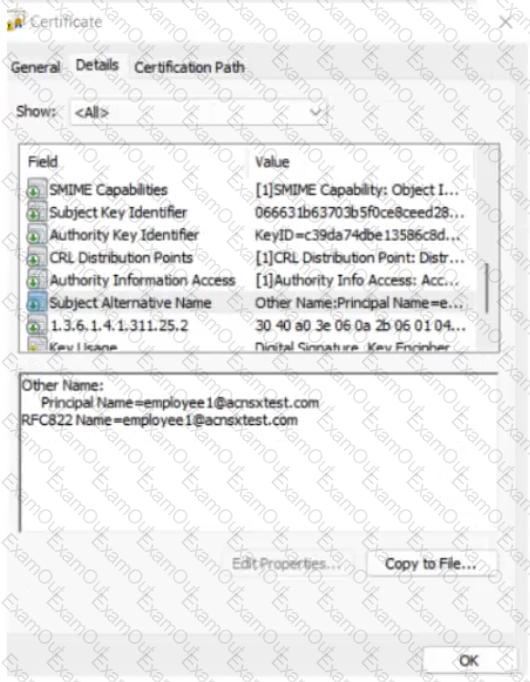
The company is in the process of adding Microsoft Endpoint Manager (Intune) to manage its mobile clients. The customer is maintaining the on-prem AD for now and uses Azure AD Connect to sync with Azure AD.
# Requirements for issuing certificates to mobile clients
The company wants to use ClearPass Onboard to deploy certificates automatically to mobile clients enrolled in Intune. During this process, Onboard should communicate with Azure AD to validate the clients. High availability should also be provided for this scenario; in other words, clients should be able to get certificates from Subscriber 2 if Subscriber 1 is down.
The Intune admins intend to create certificate profiles that include a UPN SAN with the UPN of the user who enrolled the device.
# Requirements for authenticating clients
The customer requires all types of clients to connect and authenticate on the same corporate SSID.
The company wants CPPM to use these authentication methods:
 EAP-TLS to authenticate users on mobile clients registered in Intune
EAP-TLS to authenticate users on mobile clients registered in Intune
 TEAR, with EAP-TLS as the inner method to authenticate Windows domain computers and the users on them
TEAR, with EAP-TLS as the inner method to authenticate Windows domain computers and the users on them
To succeed, EAP-TLS (standalone or as a TEAP method) clients must meet these requirements:
 Their certificate is valid and is not revoked, as validated by OCSP
Their certificate is valid and is not revoked, as validated by OCSP
 The client’s username matches an account in AD
The client’s username matches an account in AD
# Requirements for assigning clients to roles
After authentication, the customer wants the CPPM to assign clients to ClearPass roles based on the following rules:
 Clients with certificates issued by Onboard are assigned the “mobile-onboarded” role
Clients with certificates issued by Onboard are assigned the “mobile-onboarded” role
 Clients that have passed TEAP Method 1 are assigned the “domain-computer” role
Clients that have passed TEAP Method 1 are assigned the “domain-computer” role
 Clients in the AD group “Medical” are assigned the “medical-staff” role
Clients in the AD group “Medical” are assigned the “medical-staff” role
 Clients in the AD group “Reception” are assigned to the “reception-staff” role
Clients in the AD group “Reception” are assigned to the “reception-staff” role
The customer requires CPPM to assign authenticated clients to AOS firewall roles as follows:
 Assign medical staff on mobile-onboarded clients to the “medical-mobile” firewall role
Assign medical staff on mobile-onboarded clients to the “medical-mobile” firewall role
 Assign other mobile-onboarded clients to the “mobile-other” firewall role
Assign other mobile-onboarded clients to the “mobile-other” firewall role
 Assign medical staff on domain computers to the “medical-domain” firewall role
Assign medical staff on domain computers to the “medical-domain” firewall role
 All reception staff on domain computers to the “reception-domain” firewall role
All reception staff on domain computers to the “reception-domain” firewall role
 All domain computers with no valid user logged in to the “computer-only” firewall role
All domain computers with no valid user logged in to the “computer-only” firewall role
 Deny other clients access
Deny other clients access
# Other requirements
Communications between ClearPass servers and on-prem AD domain controllers must be encrypted.
# Network topology
For the network infrastructure, this customer has Aruba APs and Aruba gateways, which are managed by Central. APs use tunneled WLANs, which tunnel traffic to the gateway cluster. The customer also has AOS-CX switches that are not managed by Central at this point.
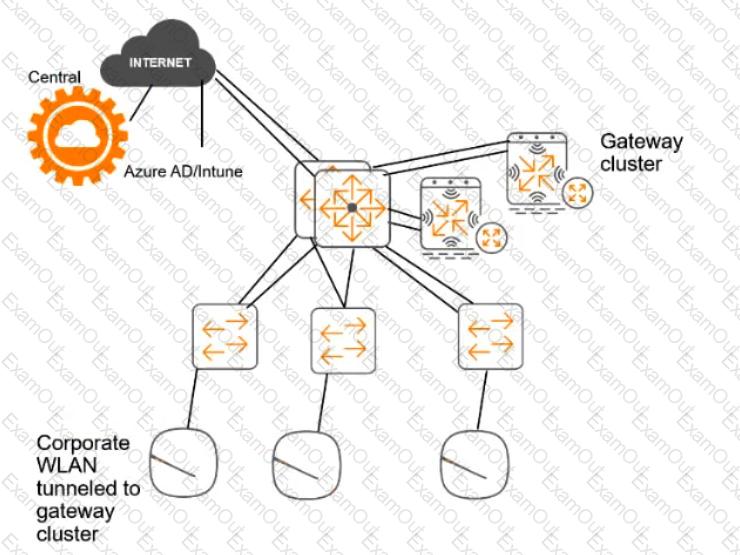
# ClearPass cluster IP addressing and hostnames
A customer’s ClearPass cluster has these IP addresses:
 Publisher = 10.47.47.5
Publisher = 10.47.47.5
 Subscriber 1 = 10.47.47.6
Subscriber 1 = 10.47.47.6
 Subscriber 2 = 10.47.47.7
Subscriber 2 = 10.47.47.7
 Virtual IP with Subscriber 1 and Subscriber 2 = 10.47.47.8
Virtual IP with Subscriber 1 and Subscriber 2 = 10.47.47.8
The customer’s DNS server has these entries
 cp.acnsxtest.com = 10.47.47.5
cp.acnsxtest.com = 10.47.47.5
 cps1.acnsxtest.com = 10.47.47.6
cps1.acnsxtest.com = 10.47.47.6
 cps2.acnsxtest.com = 10.47.47.7
cps2.acnsxtest.com = 10.47.47.7
 radius.acnsxtest.com = 10.47.47.8
radius.acnsxtest.com = 10.47.47.8
 onboard.acnsxtest.com = 10.47.47.8
onboard.acnsxtest.com = 10.47.47.8
On CPPM, you are creating the authentication method shown in the exhibit below:
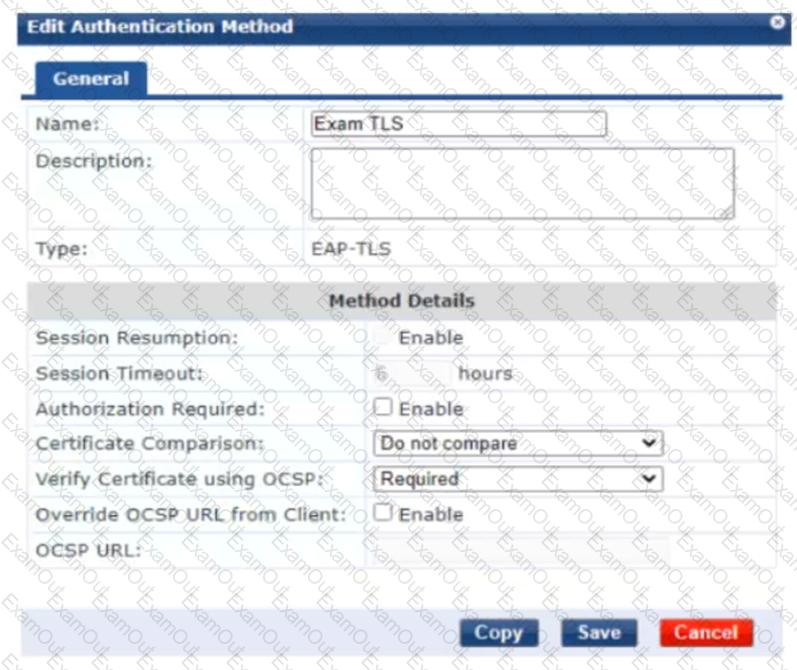
You will use the method for standalone EAP-TLS and for inner methods in TEAP.
What should you do?
Refer to the scenario.
An organization wants the AOS-CX switch to trigger an alert if its RADIUS server (cp.acnsxtest.local) rejects an unusual number of client authentication requests per hour. After some discussions with other Aruba admins, you are still not sure how many rejections are usual or unusual. You expect that the value could be different on each switch.
You are helping the developer understand how to develop an NAE script for this use case.
You are helping the developer find the right URI for the monitor.
Refer to the exhibit.
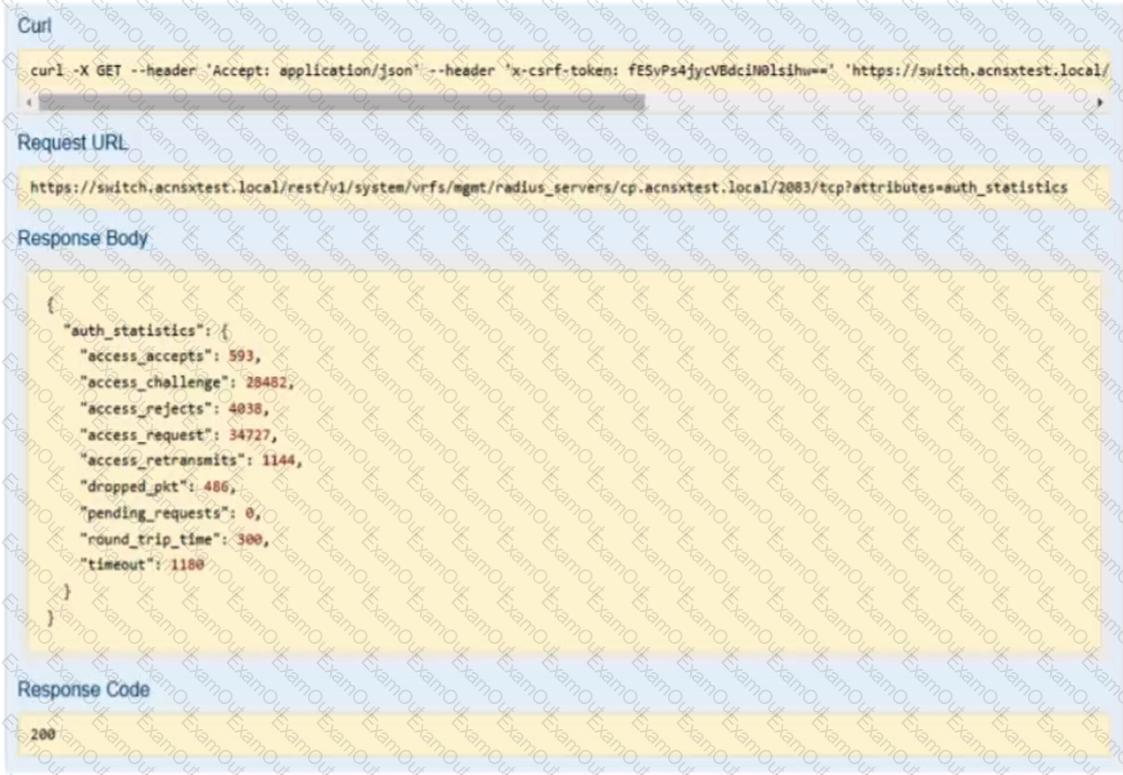
You have used the REST API reference interface to submit a test call. The results are shown in the exhibit.
Which URI should you give to the developer?

